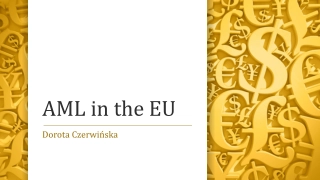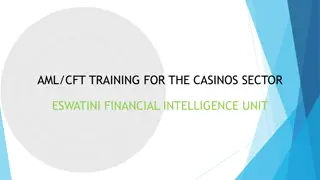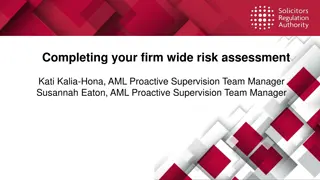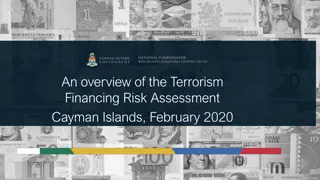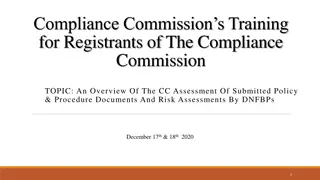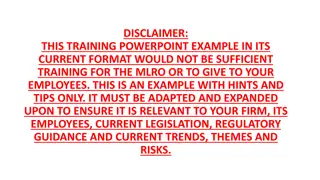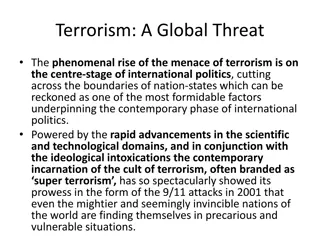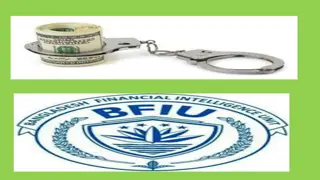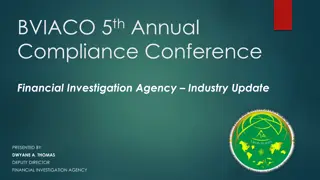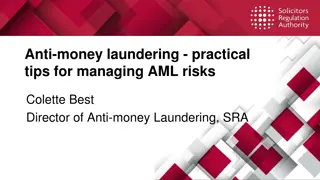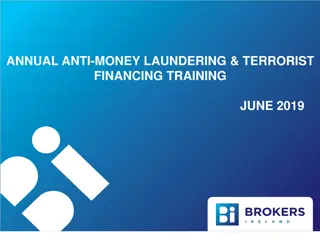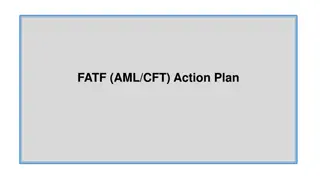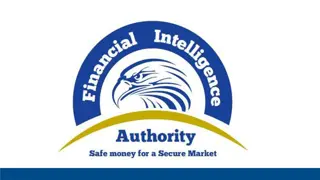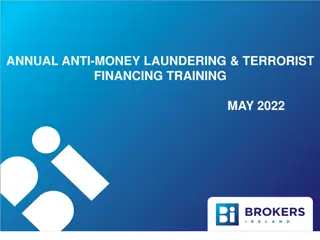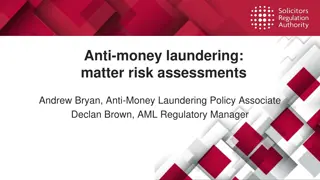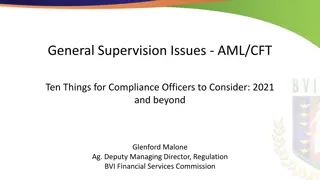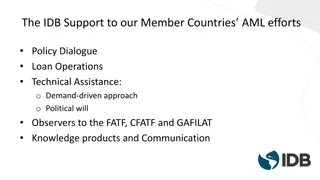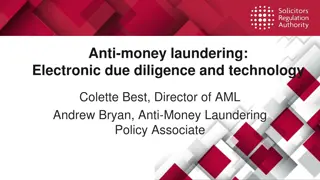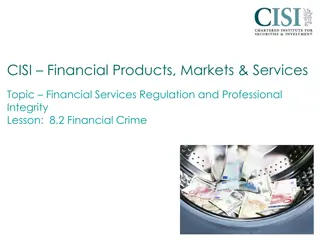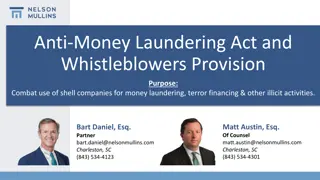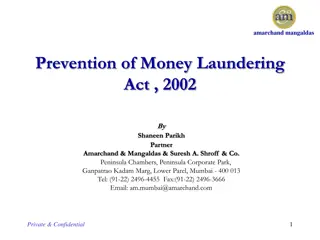Understanding Anti-Money Laundering (AML) and Combating Financing of Terrorism (CFT) Framework
Learn about the essential components of Anti-Money Laundering (AML) and Combating the Financing of Terrorism (CFT) framework, including regulatory obligations, objectives, money laundering processes, stages, sanctions, and regulatory overview. Discover how money laundering, terrorist financing, and sanctions work to prevent illegal activities in the financial system.
Download Presentation

Please find below an Image/Link to download the presentation.
The content on the website is provided AS IS for your information and personal use only. It may not be sold, licensed, or shared on other websites without obtaining consent from the author. Download presentation by click this link. If you encounter any issues during the download, it is possible that the publisher has removed the file from their server.
E N D
Presentation Transcript
Anti-Money Laundering (AML) and Combating the Financing of Terrorism (CFT) Framework December 2023
Objectives 02 Understand what are the PMLA regulatory obligations 01 03 Understand the Key Components of AML and Sanctions compliance program What is Money Laundering & Sanctions? 3
What is Money Laundering? Money Laundering (ML) involves taking criminal proceeds and disguising their illegal sources/origin in order to use the funds to perform legal or illegal activities. Criminal activities or Predicate Offenses that lead to money laundering Terrorist Financing (TF) involves the solicitation, collection or provision of funds with the intention that they may be used to support terrorist acts or organizations. Funds may stem from both legal and illicit sources Fraud Human trafficking Narcotics trade & smuggling Counterfeiting of currency Illegal arms & ammunition sale Kidnapping & extortion Bribery & corruption Wildlife poaching Tax evasion Corporate fraud Insider trading Financing of terrorism 4
Stages of Money Laundering 1 Integrating the money into the Financial System Money earned from illegal activities such as fraud, corruption etc., 2 3 Funds re-enter the economy through clean investments Criminals tries to distance the funds from the crime source
Measures or restrictions (including those often referred to as "embargoes") aimed at restricting dealings of any kind (including the provision of any services whatsoever) with another country, specific persons, legal entities, or organizations are known to be Sanctions . = What are Sanctions? Countries under the UN sanctions North Korea, Iran, Libya, Sudan, etc. Types of Sanctions Comprehensive, Sectoral, Arms/Travel/Trade/Embargoes, List Based, Secondary Sanction provisions help mitigate the Company s involvement in any restricted business activity or with a restricted entity/ country, directly or indirectly The type of Sanctions applied to a particular country, organization, group, or individual may vary across Sanctions programs. Each Sanctions program is unique and has individual requirements designed to achieve specific goals in foreign policy. For example, a Sanctions program may: ban all transactions within a given country, restrict only certain activities, restrict transactions with specific individuals, require pre-approved licenses, involve blocking or rejecting transactions. How do Sanctions work? 6
Regulatory Overview AML/CFT & Sanctions India Global Guidelines by Regulators (ICAI, ICSI, ICWAI) Financial Action Task Force (FATF) The Prevention of Money Laundering Act, 2002 (PMLA) Wolfsberg Group Financial Intelligence Unit of India (FIU-IND) Basel Committee Reserve Bank of India (RBI) Master Directions Egmont Group Unlawful Activities (Prevention) Act, 1967 United Nations Office on Drugs and Crime 8
Prevention of Money Laundering Act, 2002 (PMLA) The Prevention of Money Laundering Act, 2002 ( PMLA ) is an Act of the Parliament of India enacted to prevent money-laundering and to provide for confiscation of property derived from money-laundering. Background Reporting Entities 1 Effective July 1, 2005 Banking Companies Financial Intelligence Unit- India (FIU-IND) is the authority to implement the provisions of the Act. Stockbrokers and Sub-Brokers 2 Confiscation of property derived from, or involved in, money- laundering Insurance Companies 3 Obligation to verify identity of clients, maintain records and furnish information to Financial Intelligence Unit-India (FIU-IND) 4 Non-Banking Financial Companies Mandates appointment of a Principal Officer within a Reporting Entity Designated Non-Financial Businesses and Professions (DNFBPs) 5 Obligation for reporting entity to report cash transactions of over Rs 10 lakh to the FIU. 6 Payment System Operators Obligation to report all suspicious transactions whether or not made in cash 7 Chartered Accountants, Companies Secretaries & Cost Accountants (Professionals) FIU-IND obtains data from various intermediaries, processes the same and if required passes it on to the agency such as police, I-tax for investigation 8 Casino / Cryptocurrency 9
Global Sanctions Countries have Used to fight economically, rather than physically Prohibit transacting with sanctioned individuals and entities their own sanctions lists such as USA, European Union etc. OFAC Sanctions List (USA) United Nations Sanctions List FATF advisory The Office of Foreign Assets Control (OFAC) operates under the US Treasury Department and is responsible for administering and enforcing the United States economic and trade sanctions. United Nations it publishes a Sanction List known as the UN Sanctions which includes a list of all sanctioned individuals and entities that regulated entities in India must subject to sanction measures. FATF has 2 types of lists- Blacklist: Countries knowns as Non- Cooperative Countries or Territories (NCCTs) Grey List: Countries that are considered a safe haven for supporting ML and TF. UK HMT European Union (EU) Sanctions List Australian Sanctions The UK government publishes the UK Sanctions List, which provides details of those designated under regulations made under the Sanctions Act. EU Sanctions are linked to United Nations Security Council Resolutions, but the EU imposes its own autonomous sanctions Australia implements United Nations Security Council (UNSC) sanctions, as a member of the UN, and Australian autonomous sanctions, which are imposed as a matter of Australian foreign policy. 10
Financial Action Task Force (FATF) FATF 40 Recommendations The Financial Action Task Force (FATF) is an inter-governmental body established in 1989 to set standards and foster international action against money laundering. Group Theme The FATF comprises 37 member jurisdictions and 2 regional organizations (European Commission and Gulf Co-operation Council) representing most major financial centers in all parts of the globe. I AML/CFT Policies and Coordination (1-2) II Money Laundering and Confiscation (3-4) III Terrorist Financing and Financing of Proliferation (5-8) Financial and Non-Financial Institution Preventative Measures (9-23) IV Transparency and Beneficial Ownership of Legal Persons and Arrangements (24-25) V Powers and Responsibilities of Competent Authorities and Other Institutional Measures (26-35) VI VII International Cooperation (36-40) 11
FATF Advisories FATF has 2 types of lists: Blacklist: Countries knowns as Non-Cooperative Countries or Territories (NCCTs) Grey List: Countries that are considered a safe haven for supporting ML and TF Black-listed Countries Grey-Listed Countries Albania Barbados Burkina Faso Cameroon Cayman Islands Croatia Democratic Republic of Congo Gibraltar Haiti Jamaica Jordan Mali Mozambique Nigeria Panama Philippines Senegal South Africa South Sudan Syria Tanzania T rkiye Uganda U.A.E. Vietnam Yemen Myanmar Iran Democratic People's Republic of Korea April 2023 12
Regulatory Guidance for Professionals The Ministry of Finance (Department of Revenue), Government of India, in May 2023 notified that Professionals persons who are members holding certificate of practice issued by the Institute of Chartered Accountants of India, Institute of Company Secretaries of India and Institute of Cost Accountants of India as persons carrying on designated businesses or professions under PMLA or designated non-financial businesses and professions (DNFPBs) as under FATF guidance. This notification requires the professionals to comply with the provisions of the Prevention of Money Laundering (Maintenance of Records) Rules, 2005 (PMLA Rules, 2005) framed under the Prevention of Money Laundering Act, 2002 (PMLA Act). Professionals who qualify under the definition of Designated Non-financial Businesses and Professions (DNFPB) are expected to comply with Guidelines for Chartered Accountants, Company Secretaries and Cost Accountants issued by Financial Intelligence Unit (FIU-IND), outlining the obligations and procedures to be followed by reporting entities to ensure compliance with AML/CFT provisions. Key highlights from the AML/CFT provisions are: 1. Obligation to establish policies & procedures under PMLA 2. Detailed Guidelines on Anti Money-Laundering and combating the financing of terrorism 3. Illustrative list of documents required for KYC 4. Maintenance of records of transactions/ Information to be recorded/Preservation of records/ Cash and Suspicious transactions reporting to Financial Intelligence Unit-India (FIU-IND) 5. Implementation of Section 51A of the Unlawful Activities (Prevention) Act, 1967 (UAPA) 6. Recruitment and training of employees 7. Definitions as applicable under PMLA, 2002 13
Regulators Role Institute of Chartered Accountants of India, Institute of Company Secretaries of India and Institute of Cost Accountants of India are all Statutory Self Regulatory Bodies which regulate the respective professions in India. Each of the Institutes are tasked with the responsibility of registering, licencing and regulating the professionals who are members of the Institute. Institutes thus become Regulator within the meaning of PMLA read with PML Rules. Regulator is required to issue guidelines under PML Rules and monitor the AML/CFT requirements cast on the reporting entities. The Regulator in this case the Institutes are required to carry out a risk assessment of the professional set up in the Country and assess the risks and formulate measures for combating the risks. Conduct risk based assessment of its members at periodic intervals and provide feedback to its members generally and specifically about the AML/CFT measures required to be put in place. Have the powers to supervise and levy sanctions for violation of reporting requirements under PMLA and PML Rules. 14
Regulators Role Institute of Chartered Accountants of India has issued Know Your Customer Norms w.e.f. 1st January 2017 for its practicing members to be applied for their clients, when they render Management Consultancy and other Services. They have to generate UDIN for every financial statement related to financial audit of the company through the system developed by the ICAI. Further, The Disciplinary Board is appointed by the Central Government for taking disciplinary action the CA. The ICAI has also issued a Code of Ethics for its members including Chartered Accountants. The definition of misconduct provided therein is wide enough to cover violation of money-laundering laws. The Institute of Company Secretaries of India (ICSI) has issued an advisory dated 13th December 2022 to all its members for observing compliance to various applicable FATF Recommendations. Further, The Disciplinary Board is appointed by the Central Government for taking disciplinary action the CS. The ICSI has also issued a Code of Ethics for its members. The definition of misconduct provided therein is wide enough to cover violation of money-laundering laws. 15
Risks & Consequences of regulatory non-compliance for reporting entities Operational Challenges Legal & Regulatory Actions Reputation Damage Stoppage of work Financial Loss Termination of business license Closure of Business Investigation by authorities Dismiss of employees Restitution Closure of Business Lawsuits and arrests against the business and Individuals Possible ban on working in a specific sector High value administrative penalties Loss of Revenue Loss of customer trust Loss of Business Partners Fines of large value on the entity & employees Imprisonment Termination of Employees Irreparable reputational damage 16
Key Components of AML and Sanctions compliance program May 2023 17
Key Components of AML and CFT compliance program An AML/CFT program is an essential component of an institution s compliance regime. Such a program should be risk-based and must address 4 basic elements also known as the four pillars AML and CFT Compliance program Monitoring of transactions Regulatory Reporting 03 02 Customer Due Diligence (CDD)/ Enhanced Due Diligence Record Keeping 01 04 18
AML and Sanctions Process Flow Customer Due Diligence KYC Name Screening Risk Record Storage/ Retention Documentation Assessment Obtain Transaction Data Identify suspicious transactions Transaction Monitoring Prepare reports for reporting Report all suspicious transactions to the FIU Reporting 19
KYC verification and screening of new customer acceptance Gathering of initial KYC information of the customer or of the third party is a very important aspect. The aim of this exercise is to seek complete visibility on the customers, and third parties; their business operations, jurisdictions in which they operate, and related parties with whom they deal with, and screen them to identify the potential financial crime risks. Screening of names and aliases of individuals, entities, and groups against published sanctions lists in relevant jurisdictions True identity of the customer or the third party you are associated with; True beneficial owners, key personnel e.g. related parties, or the individual/s that are authorized to act on behalf of the customer/ third party. Conducting Negative News/ Adverse Media screening Customer s/ third party s locations of operations 20
Customer Due Diligence Procedure Step Step Step Step 1 2 3 4 Identify the customer details and obtain the duly filled declaration form from the customer. Identify the customer's associated parties/legal representatives Identify the nature of business/occupation of the customer Identify ownership details and control structure. Step Step Step Step 5 6 7 8 Identify third-party if any, as confirmed by the customer while establishing the business relationship Perform the name screening on the customer and all the associated parties including third parties identified at the time of customer due diligence process using adverse media checks and applicable sanction lists Based on the risk categorization, if a customer is established as high risk, Enhanced Due Diligence (EDD) shall be performed on the customer Upload all the KYC documents and screening results to the customer database/company servers as part of the record retention policy along with the customer contracts or other related documents obtained at the time of onboarding. 21
Risk Assessment Customer Risk Assessment enables the firm to follow a risk-based approach on AML/CFT. Risk assessment and categorization shall be undertaken based on parameters such as customer s identity, social/financial status, and information about the client s business activities and their location etc. Customer Risk Delivery Channel Geography Parameters for Assessing Risk Special Risk Factors Products & Services 22
Risk assessment for the Sector Exposure to clients in high/medium- high clients such as gems and jewellery 04 Dealing in money of clients. 03 05 Management of trusts and Companies Professionals whose majority of fees comes from clients in the notified activities Bookkeeping services including managing bank accounts etc. 02 06 Professionals dealing in Real Estate or NGO sectors Providing correspondence address or administrative address 01 07 May 2023 23
Risk assessment for the Sector Other High Risk Components Illustrative list Entity Type Others Trusts NRI - Non-Resident of India Charities High Net Worth Individuals NGOs and Organizations receiving donations PEP/Related Close Associate Family-Owned Business Negative Media - True Alert 02 Firms with sleeping partners Insufficient information provided by customer Special Purpose Vehicles (SPV) 01 07 May 2023 24
Enhanced Due Diligence Procedure Enhanced due diligence (EDD) is a step-up KYC process that provides a greater level of scrutiny to the customers who are deemed to be high risk. EDD procedures are performed on higher-risk clients, business relationships and transactions. In the case of EDD, the following are the additional steps that need to be performed. Step Step Obtain approval from the Senior Management on initiating/continuing the relationship with the customer. 01 03 Identify the source of funds (SoF) and source of wealth (SoW) of the customer. Retain all KYC documents, screening results and Senior Management approvals as part of the record retention policy. 02 Step 25
Monitoring of transactions Each transaction shall be reviewed to ensure the following- Sanctions laws impose certain prohibitions and restrictions that should be considered before initiating any transaction. Screening of the parties involved in the transaction or with whom the transaction is agreed upon. If there is a third party involved, that party should be screened as well against the Sanctions lists Transactions that are allowed under applicable Sanctions based on the guidance issued by OFAC, UN, EU, and any applicable local jurisdictions. This will require the product type(hardware or software)/ license to be screened against any applicable Sanctions lists as well. 26
Transactions covered for Professionals (Illustrative) Managing of bank, savings or securities account Buying and Selling of Real Estate Buying and selling of business entities Creating, operating or management of legal persons Organisation of contributions for the creation, operation or management of companies Financial transactions for or on behalf of client concerning all the other activities Managing client money securities or other assets 27
Reporting requirements and maintenance of records Reporting requirements Maintenance of Records In line with FATF Recommendation 20, Rule 8(2) read with Rule 3(1)(D) of the PMLR provides for prompt reporting of a suspicious transaction, which includes an attempted suspicious transaction, to the FIU-IND, if a reporting entity suspects or has reasonable grounds to suspect that funds used by a client are the proceeds of a criminal activity or are related to terrorist financing. A suspicious transaction shall be reported within seven working days of its occurrence. It is clarified that for the purpose of suspicious transactions reporting, apart from 'transactions integrally connected', 'transactions remotely connected or related' shall also be considered.` The reporting entities shall collect and maintain the following information for its customers, and third parties for at least 5 years- Business agreements between customers, third parties, and other parties, Due Diligence information obtained at the onset and during the course of a business relationship Transaction details such as Proforma Invoices, contracts, transaction details Certain transaction activities, including domestic and international fund transfers within the subsidiaries of the client if any 28


